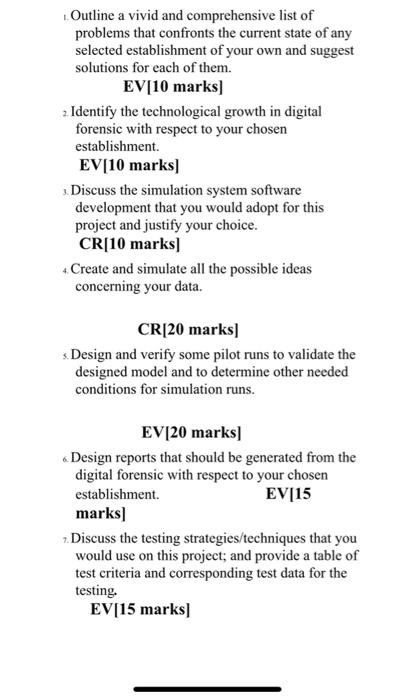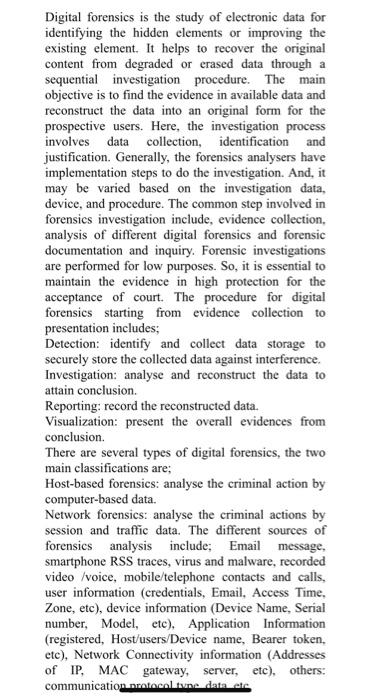1. Outline a vivid and comprehensive list of problems that confronts the current state of any selected establishment of your own and suggest solutions for each of them. EV[10 marks] 2 Identify the technological growth in digital forensic with respect to your chosen establishment. EV[10 marks] 3. Discuss the simulation system software development that you would adopt for this project and justify your choice. CR[10 marks] 4. Create and simulate all the possible ideas concerning your data. CR[20 marks] s. Design and verify some pilot runs to validate the designed model and to determine other needed conditions for simulation runs. EV[20 marks] a. Design reports that should be generated from the digital forensic with respect to your chosen establishment. EV[15 marks] 7. Discuss the testing strategies/techniques that you would use on this project; and provide a table of test criteria and corresponding test data for the testing. EV[15 marks] Digital forensics is the study of electronic data for identifying the hidden elements or improving the existing element. It helps to recover the original content from degraded or erased data through a sequential investigation procedure. The main objective is to find the evidence in available data and reconstruct the data into an original form for the prospective users. Here, the investigation process involves data collection, identification and justification. Generally, the forensics analysers have implementation steps to do the investigation. And, it may be varied based on the investigation data, device, and procedure. The common step involved in forensics investigation include, evidence collection, analysis of different digital forensics and forensic documentation and inquiry. Forensic investigations are performed for low purposes. So, it is essential to maintain the evidence in high protection for the acceptance of court. The procedure for digital forensics starting from evidence collection to presentation includes; Detection: identify and collect data storage to securely store the collected data against interference. Investigation: analyse and reconstruct the data to attain conclusion. Reporting: record the reconstructed data. Visualization: present the overall evidences from conclusion. There are several types of digital forensics, the two main classifications are; Host-based forensics: analyse the criminal action by computer-based data. Network forensics: analyse the criminal actions by session and traffic data. The different sources of forensics analysis include; Email message, smartphone RSS traces, virus and malware, recorded video /voice, mobile/telephone contacts and calls, user information (credentials, Email. Access Time, Zone, etc), device information (Device Name, Serial number, Model, etc), Application Information (registered, Host/users/Device name, Bearer token, etc), Network Connectivity information (Addresses of IP, MAC gateway, server, etc), others: communication mrotocol twone data ets 1. Outline a vivid and comprehensive list of problems that confronts the current state of any selected establishment of your own and suggest solutions for each of them. EV[10 marks] 2 Identify the technological growth in digital forensic with respect to your chosen establishment. EV[10 marks] 3. Discuss the simulation system software development that you would adopt for this project and justify your choice. CR[10 marks] 4. Create and simulate all the possible ideas concerning your data. CR[20 marks] s. Design and verify some pilot runs to validate the designed model and to determine other needed conditions for simulation runs. EV[20 marks] a. Design reports that should be generated from the digital forensic with respect to your chosen establishment. EV[15 marks] 7. Discuss the testing strategies/techniques that you would use on this project; and provide a table of test criteria and corresponding test data for the testing. EV[15 marks] Digital forensics is the study of electronic data for identifying the hidden elements or improving the existing element. It helps to recover the original content from degraded or erased data through a sequential investigation procedure. The main objective is to find the evidence in available data and reconstruct the data into an original form for the prospective users. Here, the investigation process involves data collection, identification and justification. Generally, the forensics analysers have implementation steps to do the investigation. And, it may be varied based on the investigation data, device, and procedure. The common step involved in forensics investigation include, evidence collection, analysis of different digital forensics and forensic documentation and inquiry. Forensic investigations are performed for low purposes. So, it is essential to maintain the evidence in high protection for the acceptance of court. The procedure for digital forensics starting from evidence collection to presentation includes; Detection: identify and collect data storage to securely store the collected data against interference. Investigation: analyse and reconstruct the data to attain conclusion. Reporting: record the reconstructed data. Visualization: present the overall evidences from conclusion. There are several types of digital forensics, the two main classifications are; Host-based forensics: analyse the criminal action by computer-based data. Network forensics: analyse the criminal actions by session and traffic data. The different sources of forensics analysis include; Email message, smartphone RSS traces, virus and malware, recorded video /voice, mobile/telephone contacts and calls, user information (credentials, Email. Access Time, Zone, etc), device information (Device Name, Serial number, Model, etc), Application Information (registered, Host/users/Device name, Bearer token, etc), Network Connectivity information (Addresses of IP, MAC gateway, server, etc), others: communication mrotocol twone data ets








